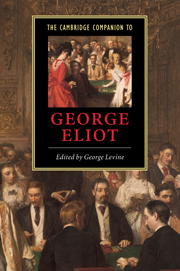Book contents
- Frontmatter
- 1 Introduction
- 2 A woman of many names
- 3 The early novels
- 4 The later novels
- 5 George Eliot and philosophy
- 6 George Eliot and science
- 7 George Eliot and religion
- 8 George Eliot and politics
- 9 George Eliot and gender
- 10 George Eliot and her publishers
- 11 George Eliot
- 12 Works cited and further reading
- Index
10 - George Eliot and her publishers
Published online by Cambridge University Press: 28 May 2006
- Frontmatter
- 1 Introduction
- 2 A woman of many names
- 3 The early novels
- 4 The later novels
- 5 George Eliot and philosophy
- 6 George Eliot and science
- 7 George Eliot and religion
- 8 George Eliot and politics
- 9 George Eliot and gender
- 10 George Eliot and her publishers
- 11 George Eliot
- 12 Works cited and further reading
- Index
Summary
George Eliot conducted her prosperous career as a novelist during a fortunate moment in the history of literary publishing in Britain. In the 1840s a generation of novelists somewhat older than Eliot - Charles Dickens, William Makepeace Thackeray, Edward Bulwer Lytton, Charlotte Brontë - had found and enlarged an audience of readers to whom fiction became a principal form, even a habit, of entertainment. By midcentury a group of well-managed and solidly capitalized publishing firms had emerged whose proprietors could pay high prices for novels they thought would be popular and who had the resources, if they guessed right, to keep novels in print, and their authors' names before the public, through successively cheaper editions. Magazines like the weeklies Household Words and All the Year Round (edited by Dickens) and the monthly Cornhill Magazine (edited by Thackeray), many of them founded in the middle of the century, used serialized fiction as a principal attraction in their competition for readers. Fiction was also a mainstay of subscription or lending libraries, at the height of their popularity in the 1850s and 1860s, from which by payment of an annual fee readers borrowed books, magazines, and the separately published installments of novels. Mudie's Select Library added almost a million volumes between 1853 and 1862, about half of them fiction, and the purchases by Mudie's and other libraries of hundreds and sometimes a thousand or more copies of three-volume editions of novels assured publishers of a profit on their first printings and made fiction accessible to the many readers unable or unwilling to buy these expensive (31 shillings and 6 pence) books.
- Type
- Chapter
- Information
- The Cambridge Companion to George Eliot , pp. 181 - 201Publisher: Cambridge University PressPrint publication year: 2001
- 5
- Cited by



